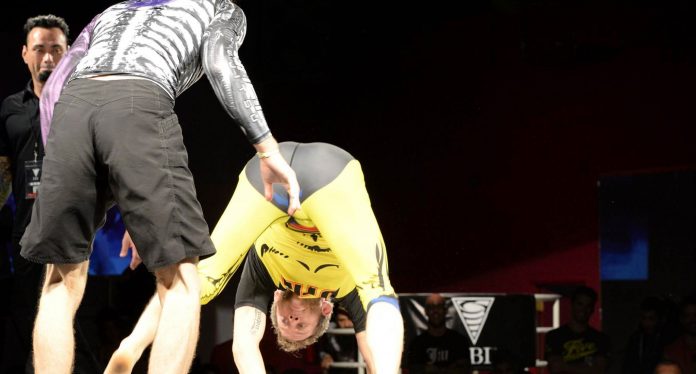
What are the weirdest guards you’ve ever played in BJJ? In all honesty, when you take an outsider’s look at things, all guard positions must seem weird. However, some are just plain ridiculous, like the Donkey Guard, for example. When Jeff Glover premiered it at Metmarois IV, I was just as taken aback as the rest of the BJJ community. We saw a few people try to emulate the guard afterward, and incidents and controversy made suer this guard became a part of Jiu-Jitsu history. That said, are you using it at all, even sporadically, or have you completely forgotten about it?
If there was ever a martial art where you can actually pull off crazy and impossible looking things in a high-level sports match or even a fight than it has to be Brazilian Jiu-Jitsu. From flying submissions to intricate ways of putting people to sleep with their own clothes, the gentle Art has really given every crazy thought a platform to actually materialize. However, I do believe that the Donkey Guard, created and pioneered by Jeff Glover, is one of the craziest things to ever come out of the BJJ world. That said, it is still a valid guard (according to me) and can come in very useful, particularly in a grappling-only competition setting.
The Origins Of The Donkey Guard
The history of the Donkey guard is a funny one, given that the position had a goal to get a rouse out of a crowd. Jeff Glover, the man behind it has always been an entertaining and highly unorthodox grappler. He is known for innovating with positions and unexpected movements every time he was competing. It didn’t matter whether he fought a world champion, or a newly promoted black belt, Jeff would do crazy things that earned him a reputation for one of the most entertaining and exciting grapplers to watch.

The idea for the move is from something that back then was a true taboo, and today is just one more aspect of the leg locking game – the Kani Basami Judo takedown, AKA the scissor throw. The Kani Basami, as legit as it is, is “outlawed” in both Judo and Brazilian Jiu-Jitsu (under most resets) so Jeff decided to create a Kani Basami-inverted guard hybrid in a legal, unusual, and highly entertaining way. It suffices to say, the position caught on fairly quickly, although it completely divided the BJJ community. It is one of those things you either love to do or hate from the bottom of your soul. Some hate it so much, in fact, that it even got banned under certain resets.
Exploring The Donkey Guard
So, what exactly is the infamous Donkey Guard? Well, simply put, there’s no simple way of explaining it. It is kind of an inverted closed guard that you do from a handstand or a headstand. Something along those lines. Let’s see how Glover does in as much of a step-by-step fashion as it is possible.


Options from this crazy position include sweeps, for the most part, especially when the legs are closed. For those more creative and adventurous, there are also back takes, spinning and rolling attacks of all kinds, as well as the mandatory leg lock entries.
So, what exactly does Donkey Guard Offer?
If you’re considering using the Donkey guard (I think everyone should), be aware that it isn’t a guard you can keep for long. In reality, it’s the exact polar opposite: a guard you sneak up on and allows for fast assaults.
Takedowns / Sweeps
From standing, as Jeff Glover did originally, you may use the Donkey guard to approach and get into a ground fight. In reality, it may even earn you takedown points.
In other words, if you remain in the guard position for longer than 5 seconds, it will be regarded as a sweep when you finally rise to the top. It is still considered a standing swap if you jump to the donkey guard and manage to get on top of someone faster.
The distinction is largely academic, as both takedowns and sweeps count for two points under IBJJF rules.
A Kani Basami (scissor takedown) is another simple option. All you have to do is angle a little towards one side of the opponent’s hips and scissor your legs. You’ll be putting yourself at the ref’s mercy with this takedown, even though it’s unusual because it’s against the rules in many events.
Another choice is to do a “wheelbarrow roll” after establishing Donkey guard control, ending up behind them with access to their back. Getting back mount allows you to take top control, giving you sweep points as well as back points.
Submissions
Given that the opponent’s legs are now in close proximity to your arms and torso, while your legs are safely around their hips, leg locks are the most popular submissions.
You may set up kneebars, toe holds, or even go deep into heel hook attacks after securing an Ashi Garami that allows you to pin your opponent’s hip to the ground. Rolling forward will allow you to set up knee bars and toe holds while a Kani Basami takes you down the road of heel hooks.
Glover has a so-called donkey guillotine, which is more insane. While he does not set it up from the inverted guard, it is still part of his strategy since he approaches it by turning his back. As Jeff turns, one of his arms is wrapped around behind his back, drawing an opponent in order for him to apply a Guillotine choke with both hands behind his back.
Transitions
You may always count on the Donkey Guard as a means of shifting to other guards. Jumping into the Donkey guard from standing is an excellent way to start the encounter on your terms. After that, you can utilize the guard to enter the 50/50 or roll outwards for an Imanari roll.
Alternatively, you may use the Donkey guard to drag an opponent into a fabricated / tornado guard, allowing you to look for sweeps or submissions from there. The triangle choke is just a tap away once your adversary’s arm has gotten wedged between your legs.
Donkey Guard Controversy
The “authorities” of the BJJ world were not very kind to the Donkey guard, as you would expect. A number of the older-generation Gracie family banned it from their competitions because they felt it was inappropriate.
Furthermore, there was a notorious occurrence several years ago in which a competitor was DQed while using the Donkey guard. A purple and brown belt were paired up at a tournament, and the purple belt attempted the Donkey guard.
As he got closer, the brown belt found the technique insulting and kicked the purple belt as he was approaching! This resulted in a DQ for the brown belt, as well as increased public interest.
Is it Worth Playing?
The biggest question that comes with the Donkey Guard is whether or not it is just a Jeff Glover thing, or it can be something useful when it comes to BJJ. Let’s be honest from the get-go – forget about it in a self-defense manner. In a grappling tournament though, it is really a useful option, if you have the athletic requirements to get to the position and play it.
For me, the Donkey Guard is not the first guard I use, nor one I’d use all the time. It does come in handy to surprise people though, especially those overly serious. In rolls, it guarantees fun times, as long as you do not place any unusual expectations on it. That said, most of the folks that hate on it probably take things too seriously anyway. Unusual positions are what BJJ is all about and the Donkey Guard should, given that it is safe, should be something available to everyone to use.
On that subject, I have to address the Gracie tournament ban here. Soon after it emerged, people started messing around with the Donkey Guard in tournaments, which brought about lots of controversy. In one match between a purple and brown belt, the brown belt got a DQ because he got sick of the purple belt turning their back and looking for the Donkey Guard and kicking his opponent. All Gracie tournaments declared the position banned, under the “realism” rules which state the guard would never work in a real situation. This is opening a can of worms that would show that a solid 80 percent of sports BJJ positions and moves won’t work in the real-life altercation. That’s why it is called sports Jiu-Jitsu. It is also why I think preventing people from doing unusual stuff is actually detrimental to BJJ, rather than helpful.
All in All
The Donkey Guard is something you should at least try if you train BJJ. There’s no good reason not to try positions like this, even if it doesn’t work out for you at the moment. It won’t change your game or anything, it will just open a door to a different way of thinking, which I think is the biggest lesson we can learn from the Donkey guard. Why stay “stuck” in the traditional when BJJ still has so many unexplored areas?
Creonte – Loyalty, Disloyalty, and Traitors in Brazilian Jiu-Jitsu











































